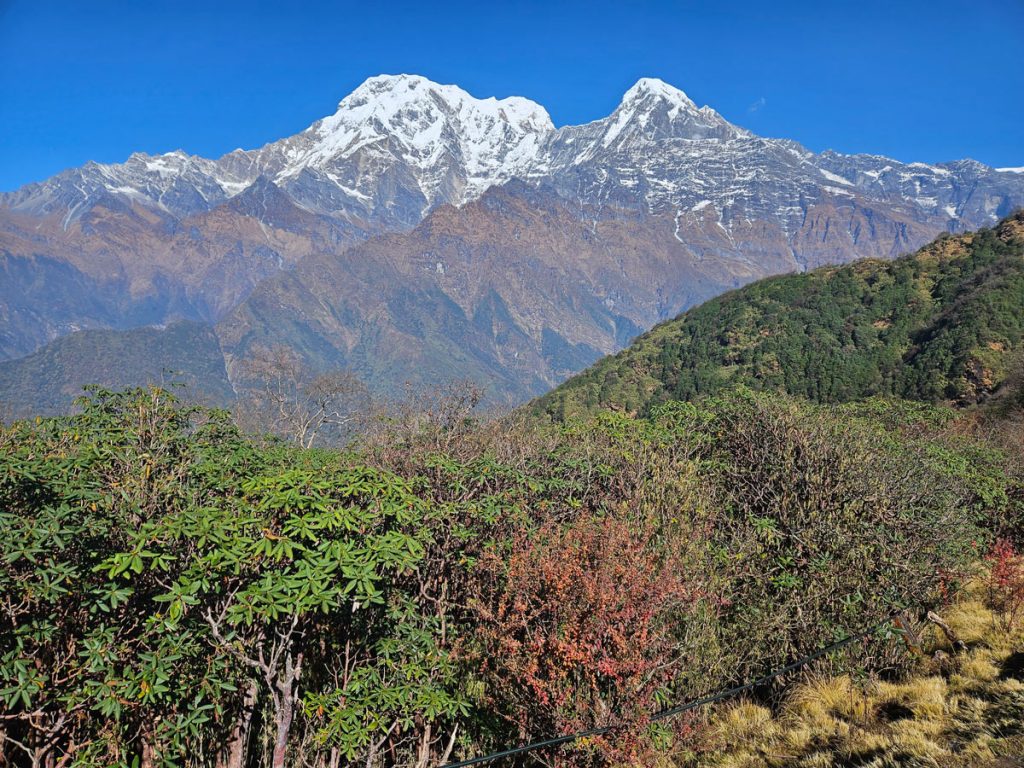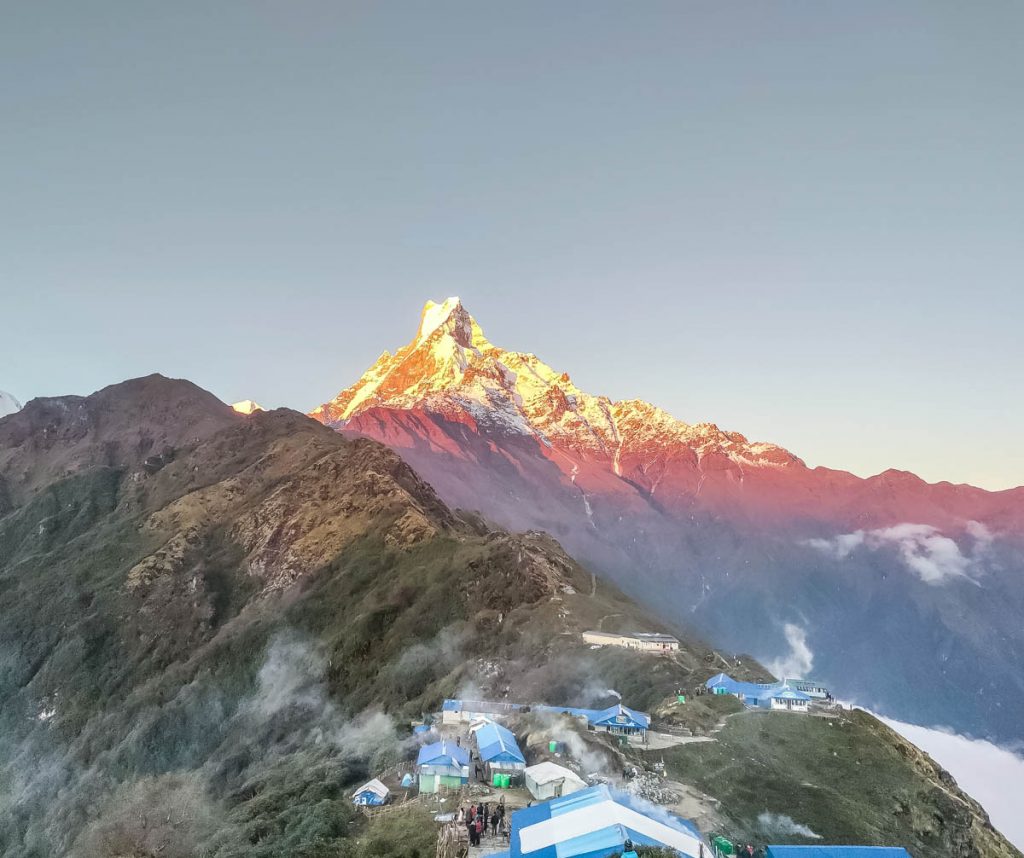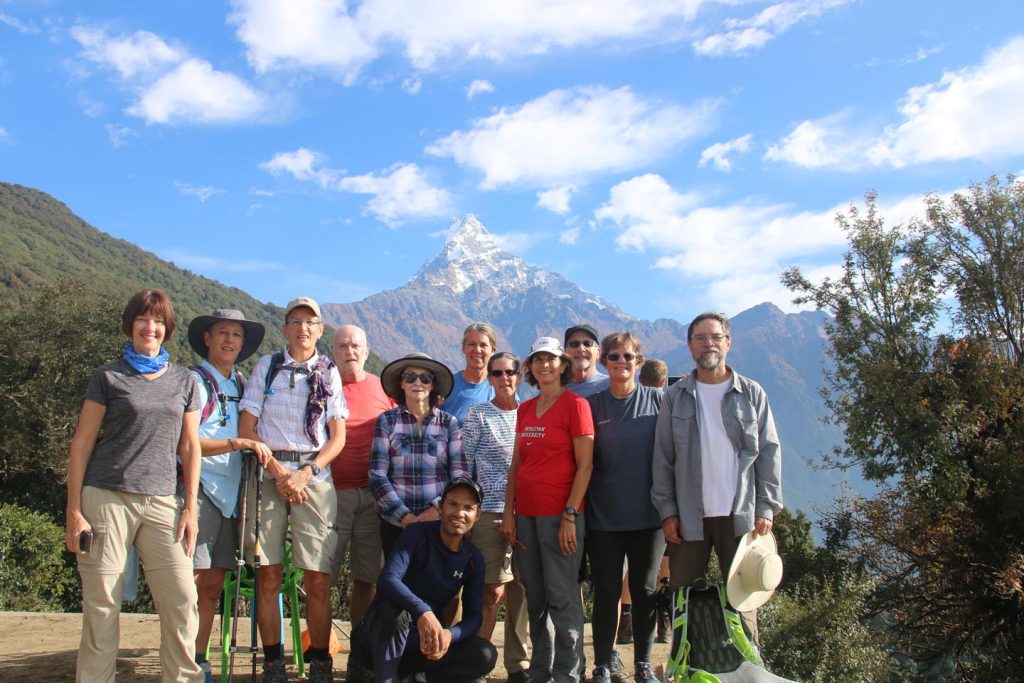Tucked away in the core of the Annapurna region, the Mardi Himal Trek is a lesser-known treasure that offers an unmatched trekking adventure.
As you journey along the trail, you will be enchanted by the rugged beauty of the stone pathways, adorned with vibrant rhododendron blooms that paint the landscapes in red, pink, and white shades.
The Mardi Himal Trek is not just a hike; it’s an immersion into the pristine wilderness and serene beauty of Nepal’s Himalayas, providing a perfect blend of adventure and tranquility.
f you’re wondering why choose Mardi Himal Trek, here are 10 compelling reasons to make it your next trekking destination.
Amongst short trekking destinations in Nepal
Starting from the picturesque city of Pokhara, this trek is an exceptional option for those seeking a brief yet fulfilling adventure in the breathtaking Himalayas, making it ideal for travelers with limited time.
Renowned as one of short treks in the Annapurna region, it is perfect for individuals searching for a condensed yet still satisfying mountain journey.

The Mardi Himal trek takes trekkers to the highest point, reaching an altitude of about 4,500 meters at Mardi Himal Base Camp, where they can witness breathtaking panoramic views of the Annapurna range, Mardi Himal, Hiunchuli Peaks.
This trek is typically designed to be completed in about 5-7 days, offering adventurers the opportunity to fully immerse themselves in the enchanting beauty of the Himalayas without having to commit to an extended expedition.
It’s a perfect choice for those looking for a memorable and easily manageable trekking experience while being able to enjoy the natural beauty of the region.
Moderate Difficulty, Maximum Reward
With its moderate level of difficulty, the trek offers a balance of challenging terrain and stunning vistas, suitable for trekkers with some experience or those in good physical condition.
Unlike more strenuous treks, the Mardi Himal route allows trekkers to experience the beauty of the Himalayas without extreme physical demands.

Remember to be physically and mentally prepared for the trek as it involves some steep sections and altitude gain. With proper preparation and pacing, most trekkers find the Mardi Himal Trek to be a rewarding and manageable adventure.
Comfortable teahouse accommodation
When embarking on the Mardi Himal trek, trekkers can find basic yet comfortable accommodations at teahouses and guesthouses along the trail.
These lodgings provide a cozy and authentic experience, offering a chance to rest and rejuvenate while immersing in the cultural richness of the region.

During the trekking experience in the Himalayas, the genuine warmth of the local hospitality and the chance to engage with the community imbue an extra dimension of richness.
These encounters with the locals not only enrich the overall experience but also create lasting memories against the backdrop of the awe-inspiring Himalayan landscapes.
Authentic Local Cuisine on the trails
The culinary scene in the Mardi Himal region is rich and diverse, with its local cuisine primarily revolving around the staple dish of Dal Bhat. This traditional Nepalese cuisine is a delightful combination of steamed rice, flavorful lentil soup, and a variety of seasoned vegetables.
In addition to Dal Bhat, visitors can savor an array of other local delicacies, including momo, which are succulent dumplings filled with a tantalizing mixture of meat or vegetables.
For those craving a warm and comforting dish, Thukpa, a hearty noodle soup, is a popular choice, while Chowmein, featuring stir-fried noodles with an assortment of savory ingredients, offers a satisfying option.
Most teahouses offer you a range of breakfast, typically comprising of eggs, toast, porridge, and a selection of tea or coffee. The emphasis on simplicity, nutrition, and flavorful cooking techniques using fresh, local produce makes the cuisine of the Mardi Himal region a genuine culinary experience.
Immerse in Unique Cultural Experiences
Engage with the local Gurung and Magar communities, explore their traditions, and participate in village festivities for a deeper cultural connection.
Along the route, you will encounter warm hospitality from the local Gurung and Magar communities. They own and operate guesthouses where you can enjoy tea or a meal, providing an authentic glimpse into their daily lives.
Traditional music and dance performances are sometimes organized in the villages, allowing visitors to appreciate local arts. These locations reflect the region’s strong Buddhist influence.
Engaging with the locals, observing their farming practices, and participating in village festivals further enriches the cultural experience on the Mardi Himal Trek, making it a memorable and immersive journey into the heart of Nepalese heritage.
Spectacular Mountain Views, Flora and Fauna
At the trek’s pinnacle, Mardi Himal Base Camp, witness breathtaking views of towering peaks like Annapurna, Machhapuchhre (Fishtail Mountain), and Mardi Himal, towering at 5,587m.
The trek also provides panoramic vistas of Annapurna South, Hiunchuli, and other peaks in the Annapurna range.

The trail is adorned with blooming rhododendron forests during spring, creating vibrant and colorful landscapes, as you ascend, you’ll pass through lush forests of oak, maple, hemlock, and rhododendron, leading to alpine meadows with stunning vistas.
The region is rich in biodiversity, with opportunities to spot various species of birds, butterflies, and occasionally larger wildlife like deer and monkeys. The trail showcases diverse plant life, from sub-tropical forests at lower altitudes to alpine vegetation at higher elevations.

Compared to other well-known treks in Annapurna, the Mardi Himal Base Camp trek is relatively less crowded, offering a more peaceful and solitary trekking experience.
The moderate difficulty of the trek, with its steep uphill and downhill, makes it suitable for trekkers with some prior experience as well as beginners with training, providing both adventure and obstacles.
Pleasant Temperatures and Scenic Seasons
Enjoy stable and pleasant weather conditions in autumn and spring, making this trek a great choice compared to other high-altitude routes.
The best time to travel to Mardi Himal is during autumn (October to November) when clear skies and stable weather make it a popular time for trekking. During this season, daytime temperatures are comfortable, but they can drop to around 0°C (32°F) or below at night and at higher elevations.
In spring (March to May), trekkers can expect mild daytime temperatures ranging from 10°C to 20°C (50°F to 68°F) at lower altitudes, while mornings and evenings at higher elevations can be colder, approaching freezing.

The summer monsoon (June to September) brings warmer temperatures and heavy rain, making the trails slippery and reducing visibility, while winter (December to February) brings much colder conditions.
It’s crucial to be well-prepared with warm clothing and gear, especially for trekking in late autumn, winter, and early spring.
These seasons make Mardi Himal a great choice for trekkers looking for stable and pleasant weather, unlike the more challenging conditions on other routes.
Affordable and Accessible
With lower costs compared to other popular treks, Mardi Himal offers a budget-friendly adventure without compromising on the stunning Himalayan experience.
Generally, the price of the Mardi Himal Trek can range from USD 800 to USD 1300 per person. The cost includes permits, lodging, meals, guide and porter services, and transportation to and from the trek starting point. It’s advisable to thoroughly review the costs and services included in different trek packages to make an informed decision.

This trek is a perfect choice for budget-conscious travelers. Compared to other popular trekking routes in Nepal, the cost of permits, accommodation and meals along the Mardi Himal Trek is relatively lower.
You can experience an authentic Himalayan trek without the high costs of more popular routes. With lower permit fees and affordable local guesthouses, Mardi Himal provides a stunning trek that won’t strain your budget, making it a great choice for those seeking an affordable Nepal adventure.
Better connectivity
While Wi-Fi isn’t widely available throughout the Mardi Himal Trek, it can be accessed in many tea houses at lower elevations, offering a chance to unplug. However, you can still check in with loved ones or share your journey when you find a signal.
The occasional Wi-Fi availability allows trekkers to stay connected without being overwhelmed by constant online access.
For those who want to stay in touch, the mobile network coverage along the Mardi Himal Trek is fairly decent. Ncell and Nepal Telecom provide coverage in most trekking regions, including Mardi Himal.
Signal strength may vary, and some higher or remote areas might have limited access, but a short climb to higher ground often restores connectivity, allowing you to make essential calls or use mobile data when necessary.
Electricity availability in the tea houses along the trek can vary. Lower elevation villages often provide 24-hour access, while as you ascend, electricity may only be available for a few hours in the evening.
Many tea houses offer charging facilities, sometimes for a small fee, making it convenient for trekkers to keep their cameras and phones ready to capture stunning landscapes. It’s recommended to bring a portable charger, power bank or adapter to ensure you never miss a photo opportunity.
Hassle-Free Permit Process
The straightforward permit acquisition and well-organized checkpoints make the Mardi Himal Trek a convenient and stress-free option.
When traveling to the Mardi Himal Base Camp, it is important to obtain two different permits: the ACAP permit (Annapurna Conservation Area Project) and the TIMS Card (Trekking Information Management System).
Both permits can be obtained in Kathmandu or Pokhara from the Nepal Tourism Board office or a trekking operator. It’s crucial to take these permits with you at all times on the walk, because you might be required to present them at several checkpoints along the way.
The Mardi Himal trek has several benefits, especially in terms of permit acquisition. Unlike some other trekking routes, the checkpoints along this trail are well-organized, ensuring that trekkers can quickly present their permits without unnecessary delays.
The straightforward and accessible permit process for the Mardi Himal trek makes it a more convenient option, especially for those looking to avoid the more complex permit procedures required for other popular trekking routes in Nepal.
Annapurna Conservation Area Permit (ACAP):
This permit is required because the Mardi Himal Trek is located within the Annapurna Conservation Area. The ACAP funds conservation activities and promotes sustainable tourism in the region. Individual costs for international countries are NPR 3000/USD 27, whereas for SAARC countries it is NPR 1000/USD 9.
Trekkers Information Management System (TIMS):
The TIMS card is essential for your safety. It assists in tracking trekkers in the area and offers critical information for search and rescue activities in the event of an emergency. Individual costs for international countries are NPR 2000/US $18, while SAARC countries are NPR 300/US $2. For international countries, the group rate is NPR 1000/US$9, while for SAARC countries, it is NPR 600/US$4.
As a conclusion, the Mardi Himal Trek emerges as an exceptional choice for adventure enthusiasts in search of a distinctive and less congested Himalayan experience.
Boasting awe-inspiring panoramic views, tranquil pathways, and hospitable tea houses, the trek offers a harmonious mix of natural splendor and cultural immersion. The limited digital connectivity along the route provides a rare chance to detach from the online world and fully immerse oneself in the breathtaking surroundings.
Whether you are an experienced trekker or a first-time explorer, the Mardi Himal Trek guarantees an unforgettable journey filled with stunning landscapes and the heartwarming hospitality of the Nepali people. Choose Mardi Himal Trek for an experience that promises tranquility, adventure, and an authentic getaway into the grandeur of nature.





